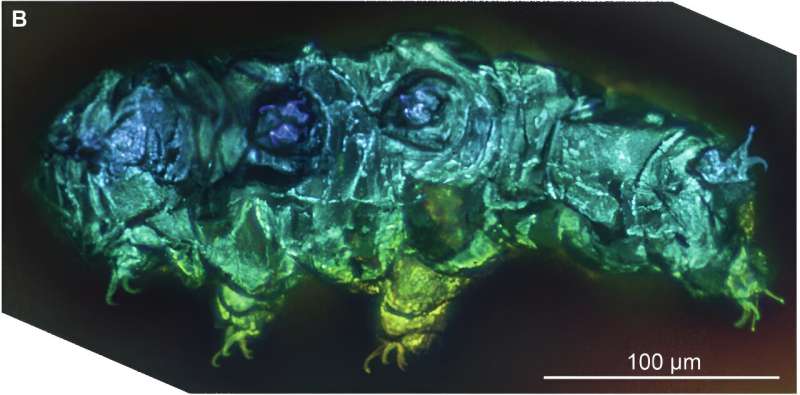August 13, 2024 report
New technology offers a better look at tardigrade fossils embedded in amber

Bob Yirka
news contributor

A trio of evolutionary biologists at Harvard University's Museum of Comparative Zoology has learned more about the evolutionary history of tardigrades by studying two fossils embedded in amber. In their study, in Communications Biology, Marc Mapalo, Joanna Wolfe and Javier Ortega-Hernánde used advanced microscopy techniques to study ancient tardigrades.
Tardigrades are a truly unique class of creature due to their ability to go into cryptobiosis when the need arises. When times get tough, they spit out all the water in their bodies and slow their metabolism to almost zero for long periods of time—they also produce a protein that protects their DNA.
Prior research has shown that when in a state of cryptobiosis, the creatures can survive in outer space, in the Arctic and even when being shot out of a high-speed gun. And while researchers have learned much about the modern version of the creatures, little is known about their evolutionary history due to a dearth of fossils.
Currently, there are only four, all bound in ancient amber. In this new effort, the researchers took a fresh look at two of the fossils frozen in time inside of a single sample of amber. Prior research had dated the amber to 72 to 83 million years ago—a time when dinosaurs were still roaming the earth.
The amber chunk has been sitting in the Museum of Comparative Zoology for years, but it was difficult to study due to its coloring, the small size of the fossils, and limitations of technology.

For this new project, the researchers used confocal fluorescence microscopy to study the two fossils—it gave them high-resolution, up-close imagery of the creatures, helping the researchers to learn more about them.
They found that neither of the tardigrades are of a species that is alive today, but both belong to families that are. They also gained some insights into the evolution of tardigrade cryptobiosis.
Comparing the fossils with other fossilized specimens and with modern species, the researchers were able to work out that at least two tardigrade groups have evolved cryptobiosis; it likely evolved in one of the groups sometime between 175 and 430 million years ago and in the other between 175 and 382 million years ago.
They suggest more fossils will need to be found in order to trace the events that led to the development of such a remarkable survival ability.
Written for you by our author —this article is the result of careful human work. We rely on readers like you to keep independent science journalism alive. If this reporting matters to you, please consider a (especially monthly). You'll get an ad-free account as a thank-you.
More information: Marc A. Mapalo et al, Cretaceous amber inclusions illuminate the evolutionary origin of tardigrades, Communications Biology (2024).
Journal information: Communications Biology
© 2024 Science X Network





















